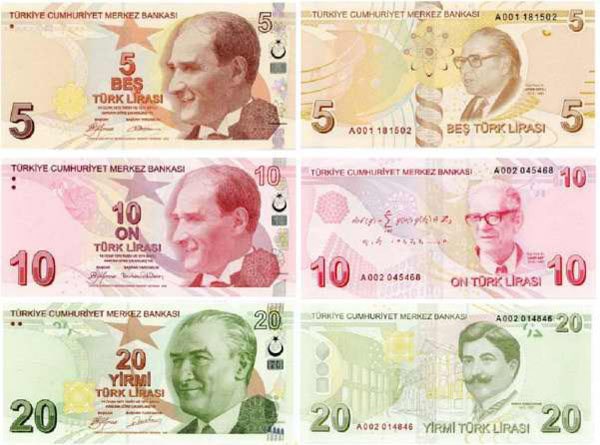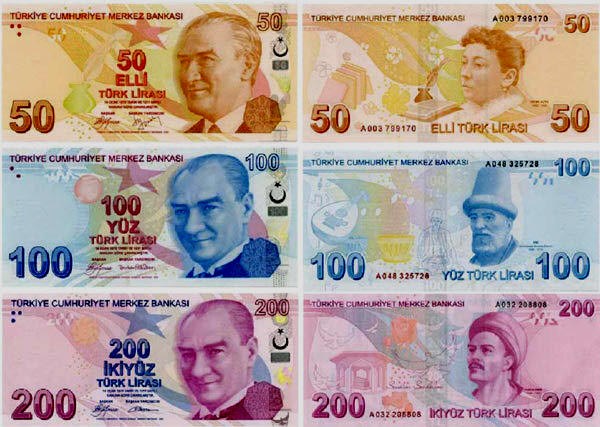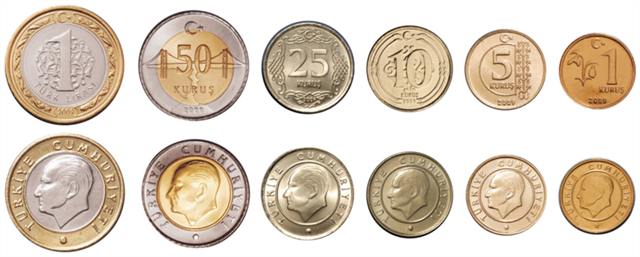The Turkish Lira:
The Turkish lira is the currency of Turkey and the Turkish Republic of Northern Cyprus (recognized only by Turkey). The Turkish lira is subdivided into 100 kuruş.
History
Ottoman lira (1844-1923) After the last vestige of the ancient Roman Empire collapsed with the Fall of Constantinople to the Ottomans, today's Turkish State Mint was founded by Mehmed II. The first golden coin was minted in the name of "The Conqueror" in 1467. The Ottoman lira remained in circulation until the end of 1927.
First Turkish lira (1923-2005) Historical banknotes from the second, third and fourth issues have portraits of İsmet İnönü on the obverse side. This change was done according to the 12 January 1926 issue of the official gazette and canceled by the Democrat Party after World War II. The Guinness Book of Records ranked the Turkish lira as the world's least-valuable currency in 1995 and 1996, and again from 1999 to 2004. The Turkish lira had slid in value so far that one original gold lira coin could be sold for 154,400,000 Turkish lira before the 2005 revaluation.
Second Turkish lira (2005-present) In December 2003, the Grand National Assembly of Turkey passed a law that allowed for re denomination by the removal of six zeros from the Turkish lira, and the creation of a new currency. It was introduced on 1 January 2005, replacing the previous Turkish lira (which remained valid in circulation until the end of 2005) at a rate of 1 second Turkish lira = 1,000,000 first Turkish lira . With the revaluation of the Turkish lira, the Romanian leu (also revalued in July 2005) briefly became the world's least-valued currency unit. At the same time, the Government introduced two new banknotes called TRY100 and TRY50. One EU diplomat has stated that Turkey will adopt the Euro if it joins the European Union.
In the transition period between January 2005 and December 2008, the second Turkish lira was officially called Yeni Türk Lirası (New Turkish lira). It was officially abbreviated "YTL" and subdivided into 100 new kuruş (yeni kuruş). Starting in January 2009, the "new" marking was removed from the second Turkish lira, its official name becoming just "Turkish lira" again, abbreviated "TL". All obverse sides of current banknotes and reverse sides of current coins have portraits of Mustafa Kemal Atatürk.
Banknotes
A new series of banknotes, the "E-9 Emission Group" entered circulation on 1 January 2009, with the E-8 group ceasing to be valid after 31 December 2009 (although still redeemable at branches of the Central Bank until 31 December 2019). The E-9 banknotes refer to the currency as "Turkish lira" rather than "new Turkish lira" and include a new 200-Turkish-lira denomination. The new banknotes have different sizes to prevent forgery. The main specificity of this new series is that each denomination depicts a famous Turkish personality, rather than geographical sites and architectural features of Turkey. The dominant color of the 5-Turkish-lira banknote has been determined as "purple" on second series of current banknotes.
Coins
From 1 January 2009, the phrase "new" was removed from the second Turkish lira, its official name in Turkey becoming just "Turkish lira" again; new coins without the word "yeni" were introduced in denominations of 1, 5, 10, 25, 50 kuruş and 1 Turkish lira. Also, the center and ring alloys of the 50 kuruş and 1 Turkish lira coins were reversed.



The appropriate permit has been obtained from the Dane County Parks Department. A copy of which is in the cache container. Please do not remove.
Congratulations to Kungfuhippie for the FTF!
